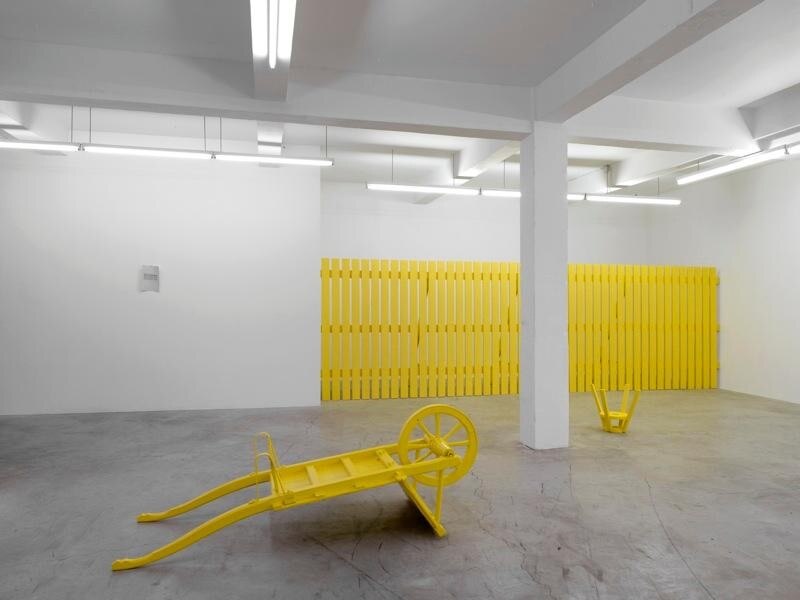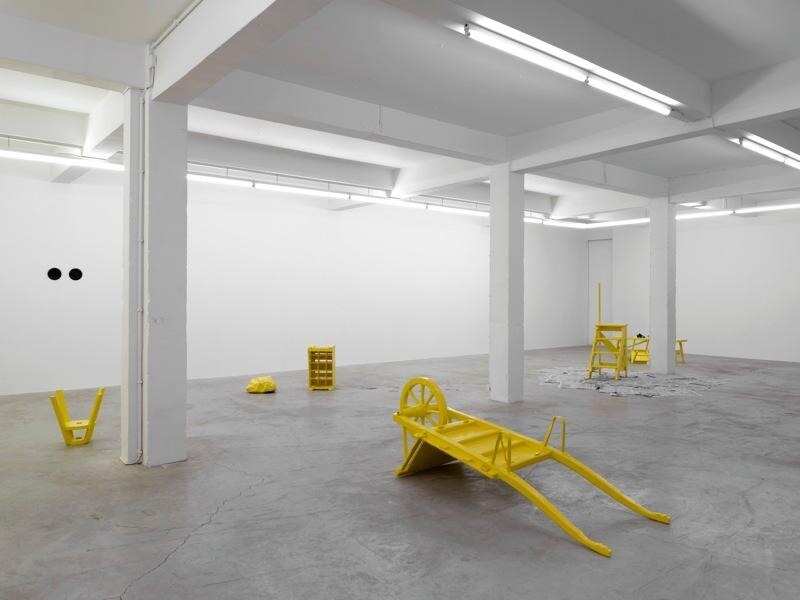Over the past summer, Sophie Nys drove 3118
kilometers around Belgium in search of the
remnants of formerly widespread pillories: wooden
or stone structures used to detain an offender and
expose them to public abuse during 1128-1851.
These artifacts often placed in locations of heavy
pedestrian traffic are testament to a time when
overt shaming was a common form of punishment.
Having visited 106 of these pillories, Nys proceeded
to photograph them, and her research forms the
basis of a publication that was launched on October
14th.
Unlike her previous projects, “The Drunkard’s
Cloak” is Nys’ first non site-specific spatial
installation; in this instance comprised of a
collection of crude objects that allude to these
pillories and the cultural mores they engender. The
objects are painted in light yellow, a color
historically viewed as the color of shame and
betrayal (yellow garments were prescribed for evil
woman and traitors; Judas is often depicted in
yellow), and hence its absence in medieval and
early renaissance paintings. Nys’ montage of
austere found objects (objects that were all used as
'temporary stages' to expose people on in times or
places where the shame pole wasn't present) are
imbued with an aura of complicity once enveloped
in this history of violent social control. A sound
recording of a scientific text describing the history
of the pillory in Belgium serves as a narrative key
to understanding this setting.
A step ladder stands literally on a discarded
witness to an appalling past: a reprint of a section
of Au Pilori, a French WWII-era anti-
Semitic newspaper from 1941, lying on the ground
as an arbitrarily chosen floor protection. As the
contemporary vehicle for public humiliation,
presenting such an extremely horrific version of the
modus operandi of the media, Nys herself exposes
the inherently abusive nature of authority.
As in her older works, Nys appropriates mundane
objects (bricks, an old toilet seat, a public sign…)
and by way of juxtaposition or re-contextualization,
she alludes to the meanings instilled in these
objects at a particular moment in modern history.
Although often intrigued by the languages of
Conceptual and Minimal art of the recent past, in
“The Drunkard’s Cloak” Nys reaches further into
history for the roots of today’s mechanisms of
social control. Unceremoniously hanging on a wall
at the entrance of the exhibition, a newspaper
clipping from De Dordtenaar of August 31,
2010, reports on an attempt by Food authorities to
expose the hygiene levels of restaurant kitchens
through a publicly placed insignia available for
public perusal. Stigmatization, in its contemporary
forms, perhaps remains an essential ingredient in
the exercise power.
The project was recently shown at Objectif
Exhibitions, Antwerp and in Artissima 17, Turin.
Sophie Nys: The Drunkard’s Cloak

View Article details
- Loredana Mascheroni
- 30 November 2010
